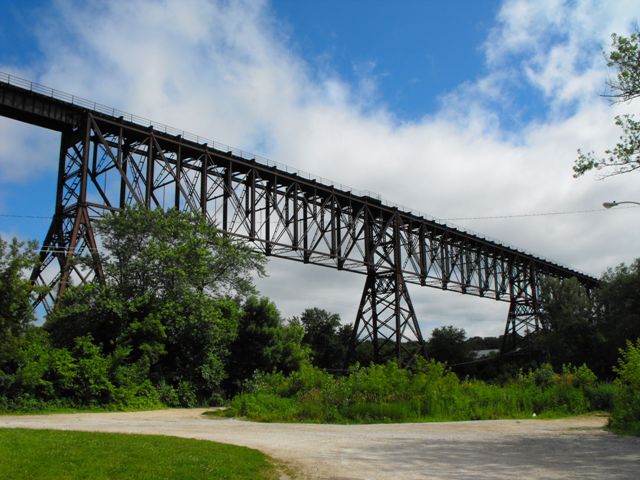We Recommend:
Bach Steel - Experts at historic truss bridge restoration.
BridgeHunter.com Phase 1 is released to the public! - Visit Now
Fort Dodge Railroad Bridge
Chicago Great Western Railroad Viaduct

Primary Photographer(s): Nathan Holth and Rick McOmber
Bridge Documented: July 2, 2009
Railroad (Union Pacific) Over Des Moines River and Other Features
Rural: Webster County, Iowa: United States
Metal 14 Panel Pin-Connected Baltimore Deck Truss, Fixed and Approach Spans: Metal Deck Girder, Fixed
1902 By Builder/Contractor: American Bridge Company of New York, New York
Not Available or Not Applicable
219.0 Feet (66.8 Meters)
2,719.0 Feet (828.8 Meters)
Not Available
4 Main Span(s)
Not Applicable

View Information About HSR Ratings
Bridge Documentation
This massive railroad bridge is considered the second largest bridge in the state of Iowa. The extremely long length of the bridge, combined with rare multi-span pin-connected Baltimore deck truss spans, and the age of this 1903 bridge make it an extremely significant engineering achievement that is both historically and technologically significant.
The Kate Shelley High Bridge, which crosses the Des Moines River down in Boone County is the only bridge larger than this railroad bridge in Fort Dodge. The Kate Shelley Bridge is similar in configuration to the Fort Dodge Railroad Bridge except that it has only a single truss span instead of four. While the Fort Dodge Railroad Bridge is nearly unheard of, the Kate Shelley Bridge gets a lot more attention than the Fort Dodge Railroad Bridge, because it has the distinction of being the tallest and longest known double-track railroad bridge. It is unfortunate that the Fort Dodge Railroad Bridge has not received more attention, since both bridges are extremely important historic bridges, and both deserve attention and research. While the Fort Dodge Railroad Bridge may not have the record-breaking statistic, it is only about a hundred feet shorter than the Kate Shelley Bridge and only a couple years newer. In addition, the Fort Dodge Railroad Bridge has a larger system of deck truss spans.
The Fort Dodge Railroad Bridge consists of four main Baltimore deck truss spans which are significant as a relatively uncommon truss design, and they are also aesthetically pleasing due to their complex geometry. These four main spans carry the bridge over the river and other features on the east side of the river. The system of main spans are flanked on each end by an extremely long series of deck plate girder spans supported by steel bents of a design that are sometimes called "towers" on large high level railroad bridges like this one. The overall historic integrity of the bridge appears to be good.
John Marvig provided the following additional information: Builders: American Bridge Company of New York (Superstructure), Bates and Rogers Construction Company of Chicago, Illinois (Substructure), Kelly-Atkinson Construction Company of Chicago, Illinois (Erection), H.C. Keith (Chief Engineer)
View Historical Article About This Bridge
![]()
Photo Galleries and Videos: Fort Dodge Railroad Bridge
Bridge Photo-Documentation
Original / Full Size PhotosA collection of overview and detail photos. This gallery offers photos in the highest available resolution and file size in a touch-friendly popup viewer.
Alternatively, Browse Without Using Viewer
![]()
Bridge Photo-Documentation
Mobile Optimized PhotosA collection of overview and detail photos. This gallery features data-friendly, fast-loading photos in a touch-friendly popup viewer.
Alternatively, Browse Without Using Viewer
![]()
Maps and Links: Fort Dodge Railroad Bridge
Coordinates (Latitude, Longitude):
Search For Additional Bridge Listings:
Bridgehunter.com: View listed bridges within 0.5 miles (0.8 kilometers) of this bridge.
Bridgehunter.com: View listed bridges within 10 miles (16 kilometers) of this bridge.
Additional Maps:
Google Streetview (If Available)
GeoHack (Additional Links and Coordinates)
Apple Maps (Via DuckDuckGo Search)
Apple Maps (Apple devices only)
Android: Open Location In Your Map or GPS App
Flickr Gallery (Find Nearby Photos)
Wikimedia Commons (Find Nearby Photos)
Directions Via Sygic For Android
Directions Via Sygic For iOS and Android Dolphin Browser
USGS National Map (United States Only)
Historical USGS Topo Maps (United States Only)
Historic Aerials (United States Only)
CalTopo Maps (United States Only)

